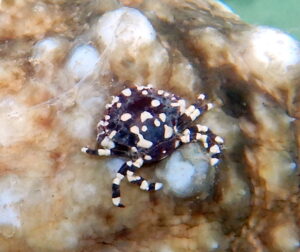
November 5, 2022
Much as I love snorkeling, some days the conditions make it hard to get in the water. That happened last week when I arrived at the beach to find the tide high, the surf rising, and the water not quite clear. I almost gave up on a morning swim, but forced myself to take the plunge. And for that effort, the ocean gave me a gift. While swimming against the strong current, I spotted a curled-up sea cucumber tumbling before me, the creature having lost its grip.
Clearly, the animal needed a hand. Once in my grip, however, I discovered that I was rescuing three animals. Two tiny crabs that I had read about but never seen, clung to the cuke’s leathery skin.
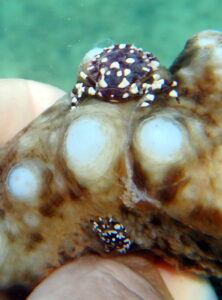
These two sea cucumber crabs managed to hang onto their host as it tumbled in the surf. ©Susan Scott
Called the sea cucumber crab, or sometimes the harlequin crab, the species lives only on a few kinds of sea cucumbers. Its favorite is the black sea cucumber, loli okuhi kuhi, one of Hawaii’s most common sea cucumber species.
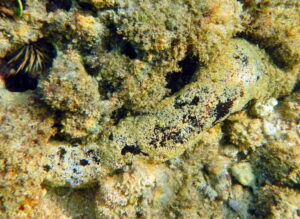
Like most sea cucumber species, the black sea cucumber, loli okuhi kuhi, uses suckered tube feet, located on its underside, to walk and to anchor itself. When coated with sand, black sea cucumbers look like sausages lying on the ocean floor or tucked into reef cracks as above. ©Susan Scott
The crab’s scientific name, Lissocarcinus orbicularis, means smooth circular crab, and although it’s a member of the swimming crab family, it does not swim. These crabs are homebodies, setting up housekeeping, often in pairs, for life in and on black or brown sea cucumbers.
The sea cucumber crab has a roundish back shell that grows about a half-inch wide. Often the crabs live in or near the mouth or anus of the sea cucumber, feasting on organic matter in the sand that the sea cucumber eats and excretes. This is a type of symbiosis called commensalism, in which one species (the crab) benefits and the other (the sea cucumber) is neither helped nor harmed.
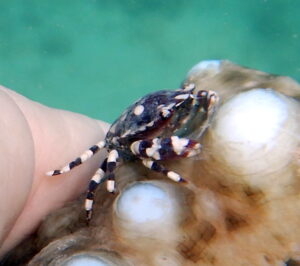
Sometimes, however, a sea cucumber crab gets a parasitic urge, and ventures onto its host’s tough exterior to nibble on the cuke’s skin. On an anchored host, such walk-about is fairly safe. But when the sea cucumber loses its purchase and goes whirling, it’s like a space-walk without a tether. Somehow, the tiny crabs I found were able to hang on in spite of North Shore surf and human handling.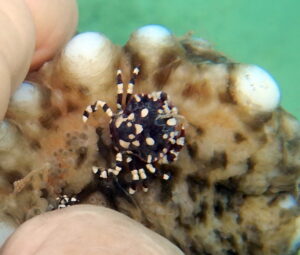
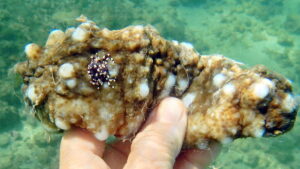
I don’t know what kind of sea cucumber this is. I suspect the white knobs were skin abrasions from being bashed around the rocky reef. Of the world’s 1,200 or so sea cucumber species, Hawaii hosts about 50. ©Susan Scott
I spent considerable time in the turbulent water trying to hold myself, my camera, and the sea cucumber still enough to shoot pictures. Eventually, the sea cucumber got upset over such handling, and ejected its guts. Sea cucumbers do that when stressed, but it doesn’t kill them. The innards grow back.
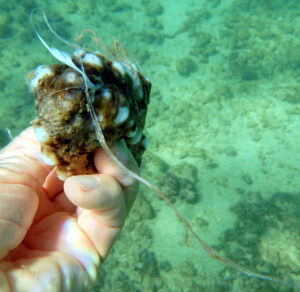
The white threads here are the sea cucumber’s internal organs, ejected through the anus, likely a ploy to divert a predator’s attention. ©Susan Scott
After the sea cucumber, crabs and I had been pushed and pummeled among the reef rocks, my final challenge was finding a hole where the sea cucumber could recover from the ordeal. The waves washed the animal out of several tiny caves, but eventually I wedged the creature into an extra deep hole. When I checked back later, the sea cucumber, hopefully with its attractive hitchhikers, was still there.
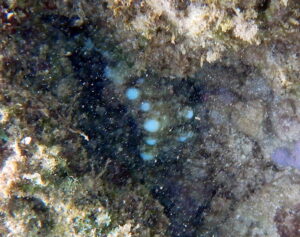
My sea cucumber remained snug in this hole. It takes several months for ejected organs to regrow. During that time, the sea cucumber can’t eat by sand sifting, but may absorb nutrients through the skin. Because crabs eat just about anything, I’m betting the hitchhikers will thrive. ©Susan Scott
After years of snorkeling and diving in Hawaii, I’m still amazed by how often, and how easily, I find something new to marvel over, photograph, and read up about. All it takes in the winter is the will power to get in the water.